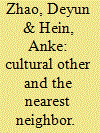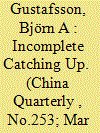| Srl | Item |
| 1 |
ID:
147871


|
|
|
|
|
| Summary/Abstract |
Greater Liangshan is one of the few regions of China where, among 70–80% of Nuosu, the Han are a minority. Instead of the much more common phenomenon of ‘Hanification,’ here we can observe Han absorbing traits of other ethnic groups. Based on two seasons of fieldwork combined with historical texts and previous ethnographic research, this paper discusses this phenomenon, raising issues of ethnic identity and the influence of local circumstances on interethnic relations. Throughout the paper, it becomes clear that there is no simple dichotomy between Han and Nuosu, but that the situation is considerably more complex. The Nuosu fall into several castes, and the Han settlers had two different experiences. Some were captured as slaves and tried to become fully Nuosu. Ethnic relations in the Greater Liangshan are thus highly complex and require more research to be thoroughly understood.
|
|
|
|
|
|
|
|
|
|
|
|
|
|
|
|
| 2 |
ID:
190413


|
|
|
|
|
| Summary/Abstract |
This paper explores household income per capita for the rural Yi and Manchu ethnic minority groups and the Han majority using data from the China Household Income Project 2002, 2013 and 2018. The disparity between total per capita income for the Yi and Han populations narrowed, while the average per capita income for the Manchu population remained relatively similar to that of the Han population. Decomposing total income to its sources shows that the rapid increase in agricultural income among the Yi was a main reason why the disparity in income, compared to the two other ethnic groups, narrowed. Nevertheless, reliance on agricultural income among the Yi was reduced as wage employment and migration increased. The Manchu group and the Han group also experienced rapid increases in wages and self-employment income. The aggregated value of transfers from the public sector was similar for all three ethnic groups.
|
|
|
|
|
|
|
|
|
|
|
|
|
|
|
|
| 3 |
ID:
153003


|
|
|
|
|
| Summary/Abstract |
Studies on ethnic minorities for the Republican period (1912–1949) highlight the political agency these groups displayed in their negotiations with the modern Chinese state. Most of this work has focused on those non-Han groups officially recognized as part of the Five-Race Republic (wuzu gonghe). Little is known, however, about those excluded from the early Republic’s flag such as the Yi inhabiting southwest China. This article discusses the role played by a group of Yi leaders who engaged with Sun Yat-sen’s ideology of nationalism, racial equality, and anti-imperialism in their attempts to obtain both recognition and aid from the Chinese nation–state. Rather than rejecting the commonly used term to identify China’s non-Han population of ‘weak and small races’ present in Sun Yat-sen’s ideology, Yi elites appropriated this term to their advantage seeking aid from the Guomindang but at the same time placing boundaries to what they perceived to be a Han-centered state.
|
|
|
|
|
|
|
|
|
|
|
|
|
|
|
|